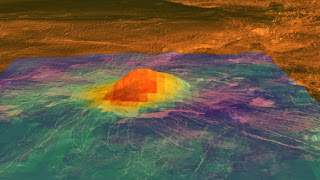 | |||
| This
hot spot on Idunn Mons, a volcano on Venus, was discovered by Suzanne
Smredar and her coworkers in 2010. Here, Magellan radar imagery (in
brown) is draped over Magellan topographic data, showing off the
landscape of the region. The elevation has been exaggerated 30 times in
order to highlight the topography. On top of all this, data from the
Visible and Infrared Thermal Imaging Spectrometer (VIRTIS) instrument on
board ESA’s Venus Express orbiter, is overlain to show temperature
variations. Red colours indicate the warmest places and purple the
coolest. This hot spot is thought to indicate the presence of
geologically young lava flows, less than 2.5 million years old, but it
does not prove the existence of current active volcanism. More details and the original image can be found at http://sci.esa.int/venus-express/46816-surface-warmth-on-a-volcano-on-venus/ Image Credit: ESA/NASA/JPL |
Venus, despite being similar to the Earth in mass and size, is a very different kind of planet. It is shrouded in a thick atmosphere of carbon dioxide and has clouds of sulfuric acid. As a result of this thick atmosphere, pressure on the surface of Venus is 93 times the atmospheric pressure on the surface of the Earth and temperatures are a sizzling 900 degrees Fahrenheit.
The thick atmosphere also makes it very difficult to see the surface of Venus. Regular cameras that capture visible light can’t see beneath the thick atmosphere. However, radar and infra-red instruments can penetrate the dense atmosphere to let us study the planet’s surface. From 1990-1994, NASA’s Magellan mission mapped the entire surface of Venus using radar. More recently, the Venus Monitoring Camera (VMS) on board the European Space Agency’s Venus Express mission has been gathering data from both the planet’s surface and atmosphere.
| NASA’s Magellan mission to Venus mapped the entire surface of the
planet, using radar instruments to peer beneath the thick atmosphere
that otherwise obscures the surface of Venus from view. This image is
centred more-or-less on Diana Chasma. Maat Mons is the purple/pink volcano north east of centre with Ganiki Chasma extending northward nearby. This image can be found at http://photojournal.jpl.nasa.gov/catalog/PIA00159 Image Credit: NASA/JPL/USGS |
Such data can only be collected at night, when heat from the sun is not a factor, and only when cloud variability is low, to ensure that differences are in fact due to changes at the surface. With these constraints, the team was able to collect data from a total of 36 different orbits of the Venus Express spacecraft, providing a series of observations over time.
From the VMS time series data, Eugene Shalygin and his team observed a number of bright spots, representing an estimated 980-1520 degrees Fahrenheit, well above planet's typical temperatures. Most spectacularly, these bright spots appeared suddenly (after having been absent in preceding orbits), persisted through several orbits, and then disappeared in subsequent orbits. “We were looking for these spots for several years (and) didn't find," anything, said Alexander Bazilevskiy, a senior scientist on the team. The scientists conclude that these transient bright spots must represent some kind of localized process that released hot matter to the surface in a short period of time. In other words, these spots suggest that an active volcanic event occurred right before our eyes!
All of the identified bright spots are located at the edge of Ganiki Chasma, a young rift zone in the vicinity of Maat Mons. Maat Mons is a tall shield volcano that erupted between 10 -20 million years ago, so this region is known to have been volcanically active in the past. The bright spots could, therefore, represent either long lava flows, which stretch for about 25 kilometers (16 miles), or a chain of small cinder cones or volcanic hot spots.
| Maat Mons is a very large shield volcano on the surface of Venus. It
is thought to have erupted between 10 -20 million years ago. Potential
evidence of current volcanic activity has been found in the vicinity of
this large volcano.This image shows a computer-generated perspective view of the volcano, looking from the north. This image can be found at http://photojournal.jpl.nasa.gov/catalog/PIA00106 Image Credit: NASA/JPL |
But, before getting too excited, we should be cautioned that the volcanic nature of the observed bright spots has not yet been confirmed. Shalygin and his team plan to look for more bright spots in the VMS data and also to sift through the historical Magellan radar data to see if they can find additional evidence of volcanic activity.
For more details on the location of the spots and to see an example of the VMS discovery data, check out Lunar and Planetary Science Conference Abstract #2556, where Shalygin and his team first presented their findings.
Sources:
Hall, S. Active Volcanoes on Venus? Sky and Telescope, March 24, 2014.
http://www.skyandtelescope.com/astronomy-news/active-volcanoes-on-venus/
Klotz, I. Active Volcanoes Revealed on Venus, Discovery News, March 18, 2014, Space.com http://www.space.com/25106-venus-volcanoes-active.html
Shalygin, E.V. et al. Bright transient spots in Ganiki Chasma, Venus. 45th Lunar and Planetary Science Conference, Abstract #2556, 2014. http://www.hou.usra.edu/meetings/lpsc2014/pdf/2556.pdf
No comments:
Post a Comment